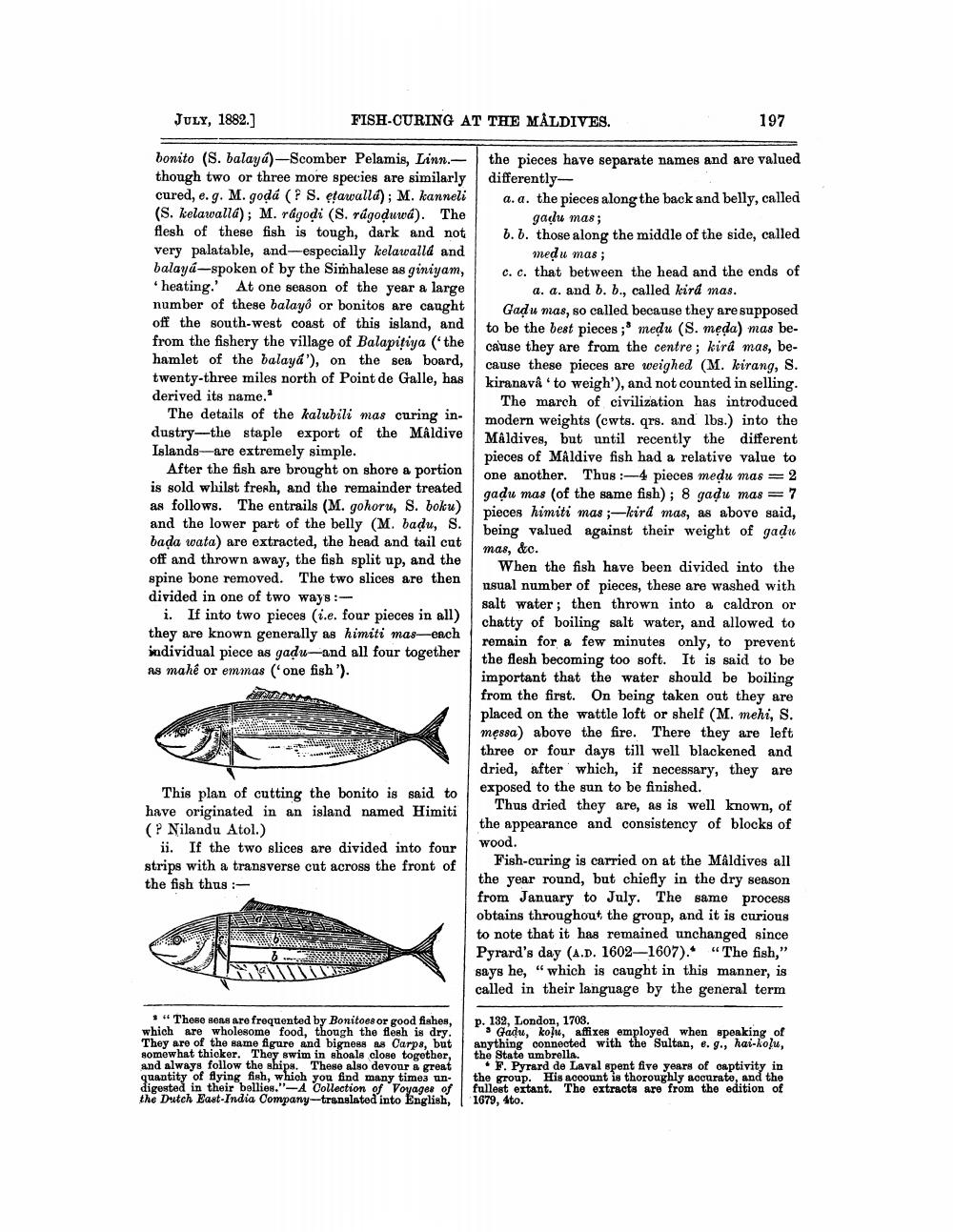________________
JULY, 1882.]
FISH-CURING AT THE MALDIVES.
bonito (S. balaya)-Scomber Pelamis, Linn.though two or three more species are similarly cured, e. g. M. godá (? S. etawalla); M. kanneli (S. kelawalla); M. rágodi (S. rúgoḍuwa). The flesh of these fish is tough, dark and not very palatable, and-especially kelawalla and balaya-spoken of by the Simhalese as giniyam, 'heating. At one season of the year a large number of these balayo or bonitos are caught off the south-west coast of this island, and from the fishery the village of Balapitiya ('the hamlet of the balaya'), on the sea board, twenty-three miles north of Point de Galle, has derived its name."
The details of the kalubili mas curing industry-the staple export of the Maldive Islands are extremely simple.
After the fish are brought on shore a portion is sold whilst fresh, and the remainder treated as follows. The entrails (M. gohoru, S. boku) and the lower part of the belly (M. badu, S. bada wata) are extracted, the head and tail cut off and thrown away, the fish split up, and the spine bone removed. The two slices are then divided in one of two ways:
i. If into two pieces (i.e. four pieces in all) they are known generally as himiti mas-each individual piece as gadu-and all four together as mahê or emmas ('one fish').
This plan of cutting the bonito is said to have originated in an island named Himiti (P Nilandu Atol.)
ii. If the two slices are divided into four strips with a transverse cut across the front of the fish thus:
"These seas are frequented by Bonitoes or good fishes, which are wholesome food, though the flesh is dry. They are of the same figure and bigness as Carps, but somewhat thicker. They swim in shoals close together, and always follow the ships. These also devour a great quantity of flying fish, which you find many times undigested in their bellies."-A Collection of Voyages of the Dutch East-India Company-translated into English,
197
the pieces have separate names and are valued differently
a. a. the pieces along the back and belly, called gadu mas;
b. b. those along the middle of the side, called meḍu mas;
c. c. that between the head and the ends of a. a. and b. b., called kirá mas. Gaḍu mas, so called because they are supposed to be the best pieces; medu (S. meda) mas because they are from the centre; kira mas, because these pieces are weighed (M. kirang, S. kiranavâ to weigh'), and not counted in selling.
The march of civilization has introduced modern weights (cwts. qrs. and lbs.) into the Maldives, but until recently the different pieces of Maldive fish had a relative value to one another. Thus :-4 pieces meḍu mas = 2 gadu mas (of the same fish); 8 gadu mas= pieces himiti mas;-kird mas, as above said, being valued against their weight of gadu mas, &c.
7
When the fish have been divided into the usual number of pieces, these are washed with salt water; then thrown into a caldron or chatty of boiling salt water, and allowed to remain for a few minutes only, to prevent the flesh becoming too soft. It is said to be important that the water should be boiling from the first. On being taken out they are placed on the wattle loft or shelf (M. mehi, S. messa) above the fire. There they are left three or four days till well blackened and dried, after which, if necessary, they are exposed to the sun to be finished.
Thus dried they are, as is well known, of the appearance and consistency of blocks of wood.
Fish-curing is carried on at the Maldives all the year round, but chiefly in the dry season from January to July. The same process obtains throughout the group, and it is curious to note that it has remained unchanged since Pyrard's day (A.D. 1602-1607). "The fish," says he, "which is caught in this manner, is called in their language by the general term
p. 132, London, 1703.
Gadu, kolu, affixes employed when speaking of anything connected with the Sultan, e. g., hai-kolu, the State umbrella.
F. Pyrard de Laval spent five years of captivity in the group. His account is thoroughly accurate, and the fullest extant. The extracts are from the edition of 1679, 4to.




